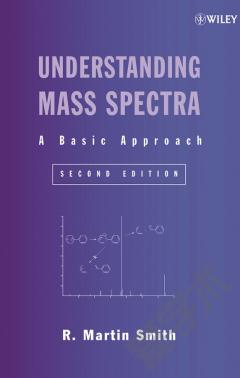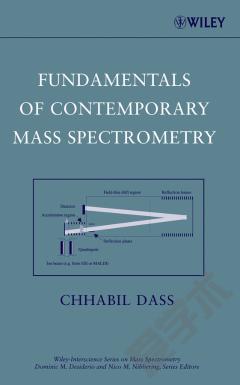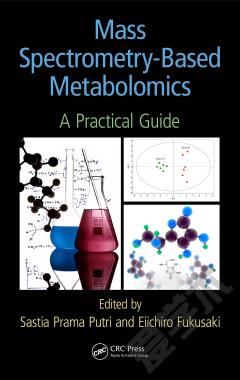Understanding Mass Spectra —— A Basic Approach
----- 了解质谱:基本方法
Preface to the Second Edition. Acknowledgments. Abbreviations and Notations Used in This Book. 1. Instrumentation. 1.1. Introduction. 1.1.1. Overview. 1.1.2. Sample Introduction. 1.2. Ionization Source. 1.2.1. Electron Ionization Source. 1.2.2. Chemical Ionization. 1.2.3. Other Ionization Methods. 1.2.3.1. Electrospray Ionization. 1.2.3.2. Desorption Ionization. 1.3. m/z Analysis. 1.3.1. Time-of-Flight (TOF). 1.3.2. Magnetic Sector. 1.3.3. Transmission Quadrupole. 1.3.3.1. Selected Ion Monitoring (SIM). 1.3.4. Quadrupole Ion Trap (QIT). 1.3.5. Other Types of Mass Analysis. 1.3.5.1. Mass Spectrometry/Mass Spectrometry(MS/MS). 1.3.5.2. Accurate m/z Analysis. 1.3.6. Spectral Skewing. 1.4. Ion Detection. 1.4.1. Electron Multiplier. 1.4.2. Photomultiplier Detector. 1.5. Data System. 1.5.1. Instrument Tuning and Calibration. 1.5.2. The Mass Spectrum. 1.5.2.1. Production of the Mass Spectrum. 1.5.2.2. Terminology: Ions vs. Peaks. 1.5.3. Library Searches. 1.5.4. Using the Data System to Analyze GC/MS Data. 1.6. Criteria for Good-Quality Spectra. Additional Problems. Mass Spectrometric Resources on the Internet. References and Suggested Reading. 2. Elemental Composition from Peak Intensities. 2.1. Natural Isotopic Abundances. 2.1.1. Atomic and Molecular Mass. 2.1.2. Calculated Exact Masses and Mass Defects. 2.2. Determining Elemental Composition from Isotope Peak Intensities. 2.2.1. One or More Atoms of a Single Element. 2.2.1.1. Chlorine and Bromine. 2.2.1.2. Ion Designation and Nomenclature. 2.2.1.3. Probability Considerations with Multiple Numbers of Atoms. 2.2.1.4. Isotope Peak Intensity Ratios for Carbon-Containing Ions-The X + 1 Peak. 2.2.1.5. A, A + 1, and A + 2 Elements. 2.2.1.6. Isotope Peak Intensity Ratios for Carbon-Containing Ions-The X + 2 Peak. 2.2.1.7. Overlapping Peak Clusters-Contributions from 13C Only. 2.2.1.8. Silicon. 2.2.2. Complex Isotope Clusters. 2.2.2.1. Sulfur Dioxide. 2.2.2.2. Diazepam. 2.3. Obtaining Elemental Compositions from Isotope Peak Intensities. Examples. Additional Problems. References. 3. Ionization, Fragmentation, and Electron Accounting. 3.1. A Brief Review of Orbitals and Bonding. 3.2. Even- and Odd-Electron Species. 3.3. Site of Initial Ionization. 3.4. Types of Fragmentation. 3.5. The Nitrogen Rule. 3.6. Energy Considerations in Fragmentation Processes. 3.6.1. Fragmentation Rates. 3.6.2. Metastable Ions. 3.6.3. Energy Diagrams. 3.6.4. Stevenson's Rule. Additional Examples. Problems. References. 4. Neutral Losses and Ion Series. 4.1. Neutral Losses. 4.1.1. Losses from the Molecular Ion. 4.1.2. Loss of Small Molecules from Aromatic Ions. 4.2. Low-Mass Ion Series. 4.2.1. n-Alkane Spectra. 4.2.2. Effect of Chain Branching on the Spectra of Aliphatic Hydrocarbons. 4.2.3. Ion Series for Nonaromatic Compounds. 4.2.4. Aromatic Ion Series. 4.2.5. Use of Ion Series: Mass Chromatograms. Additional Problems. References. 5. A Rational Approach to Mass Spectral Problem Solving. 5.1. Guidelines for Solving Mass Spectral Problems. Examples. Problems. Reference. 6. a-Cleavage and Related Fragmentations. 6.1. Introduction. 6.2. Benzylic Cleavage. 6.3. Cleavage Next to Aliphatic Nitrogen. 6.3.1. Structural Relationships: a-Cleavage in 1-Phenyl-2-aminopropanes. 6.3.2. Cleavage Next to Electron-Deficient Nitrogen. 6.3.3. a-Cleavage in Complex Nitrogenous Ring Systems. 6.4. Cleavages of Aliphatic Oxygenated Compounds. 6.4.1. a-Cleavage. 6.4.2. Bond Cleavage Away from the Ionization Site. 6.4.3. Cleavage at Carbonyl Groups. 6.5. Elimination Fragmentations in Oxygen and Nitrogen Compounds . 6.5.1. Secondary Elimination from Initial a-Cleavage Ions. 6.5.2. Hydride Shifts. 6.5.3. Elimination Fragmentations of Some Aromatic Compounds. 6.5.4. Water Elimination in Aliphatic Alcohols. Examples. Additional Problems. References. 7. Important Mass Spectral Rearrangements. 7.1. Introduction. 7.2. gamma-Hydrogen Rearrangement. 7.2.1. McLafferty-Type Rearrangement. 7.2.2. gamma-Hydrogen Rearrangement in Alkylbenzenes. 7.2.3. gamma-Hydrogen Rearrangement Initiated by a Remote Ionization Site. 7.3. Cyclohexanone-Type Rearrangement. 7.4. Retro Diels-Alder Fragmentation. 7.5. Double-Hydrogen (McLafferty t 1) Rearrangement. Additional Problems. References. 8. Rationalizing Mass Spectral Fragmentations. 8.1. General Guidelines. 8.2. Loss of Small Molecules. 8.2.1. Loss of Small Molecules from Aromatic Ions Revisited. 8.2.2. gamma-Butyrolactone. 8.3. Ephedrine. 8.4. Ortho Effect: The Hydroxybenzoic Acids. Additional Problems. References. 9. Structure Determination in Complex Molecules Using Mass Spectrometry. 9.1. Introduction. 9.2. "Designer Drugs" Related to MDA. 9.3. Cocaine and Its Metabolites. 9.3.1. Peak Correlations. 9.3.2. Proposed Fragmentations. 9.3.3. Application. 9.4. Phencyclidine and Its Analogs. 9.4.1. Fragmentations of Phencyclidine. 9.4.2. Phencyclidine Analogs. 9.5. A Practical Problem. References. 10. Answers to Problems. Index.
{{comment.content}}








 京公网安备 11010802027623号
京公网安备 11010802027623号